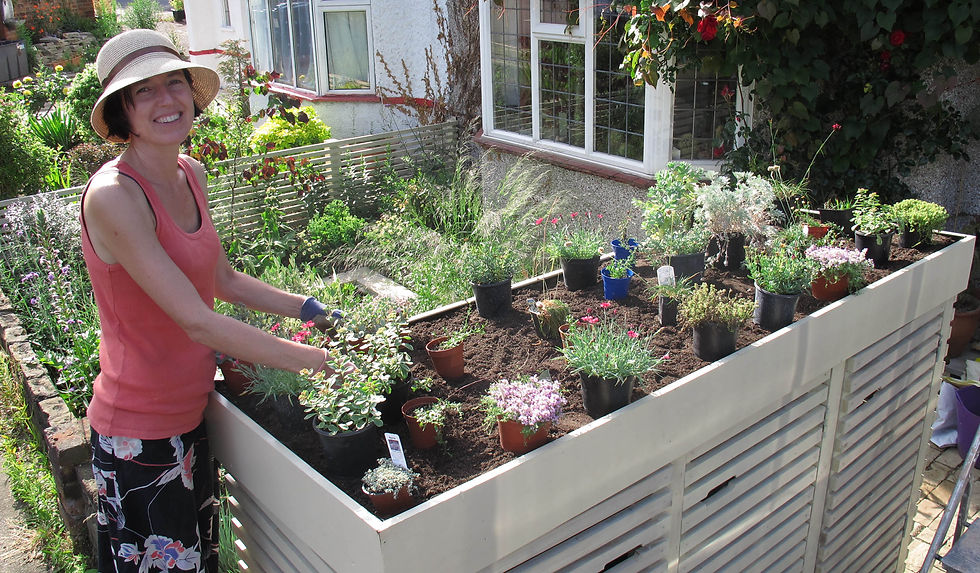How to make a Bin Store with a Green Roof
- Jo Fenton

- Sep 6, 2015
- 3 min read
Updated: Jul 1, 2024
We now have to accommodate three large wheelie bins in our front gardens in Barnet and rather than have to look at them every day I set about designing a storage cupboard to hide them. This also gave me the chance to build a small green roof, something that I have been interested in experimenting with for a while.

I built the tray to hold 100mm depth of growing medium which should allow me to grow a reasonable variety of drought tolerant plants. Once filled with soil and plants it will be heavy, so I supported it beneath with eight upright posts, joists and cross beams.

In order to stop the wood rotting I lined the tray with a butyl pond liner and stapled it into place. The roof has a slight fall towards the back for drainage and I drilled several drainage holes here to allow excess water to drain away.

The growing medium for a green roof needs to be low in nutrients and well drained. I used a mixture of John Innes No.3 compost and Lytag clay balls.

The environment I have created on the roof is a harsh one for plants. Only those suited to withstanding extremes of drought will survive as I am not planning on having to water this roof once the plants have established. Plants with succulent leaves are the best suited as they can hold water inside their leaves. I also looked for plants which have originated from similarly harsh situations such as an alpine environment.
I sourced most of these plants from Glebe Nursery in Enfield where Genine Riddell has set up a specialist Alpine and Herb Nursery alongside the existing Perennial Nursery. (www.glebenursery.co.uk) She has chosen a lovely selection of plants to grow here and sells them at very competitive prices. It is impossible not to fall in love with at least one of these tough little alpines with their delicate foliage and exquisite blooms.

Arranging the plants on the roof was fun. I want to create a series of low mounds with bobbing stems of flowers above. During the winter when there are no flowers I needed a mixture of foliage shapes and textures to keep it interesting. I bought three of each plant type from the nursery and supplemented this with some single experimental plants dug up from Annes garden in Suffolk where they are used to sharp drainage and drought.

I grouped the strong coloured plants together and interspersed the white daisy, Erigeron karvinskianus throughout in order to hold the scheme together. I am aware that the daisy is vigorous so I will have to make sure that this doesn't overwhelm the other more subtle species.

The dwarf red Dianthus has flowered continuously since I planted it, as have the daisies.

Other plants at this end include Sedum 'Bertram Anderson', Lampranthus, and Artemesia.

At the other end Sedum spurium 'Variegatum' mixes with Euphorbia myrsinites.

One advantage of the binstore green roof is that it is the perfect height to look over as you come into the house. Being at eye height you can enjoy the flowers and dainty foliage at close range. I especially enjoy it in the late afternoon when the sun shines low through the leaves.

Ideally I want to create an environment where the plants commingle without any one plant taking over. The Artemesia has already grown to twice its original size, it's soft, gossamery foliage belying its tough and vigorous nature. I shall enjoy watching how my roof garden develops over time.
I have had such an overwhelming amount of interest in my Bin Store, from all over the country, that I have produced a pack of Plans and Instructions for the DIY builder. Contact us to order your pack today.











































Wow, this adorable. Is there a instruction and material list available?